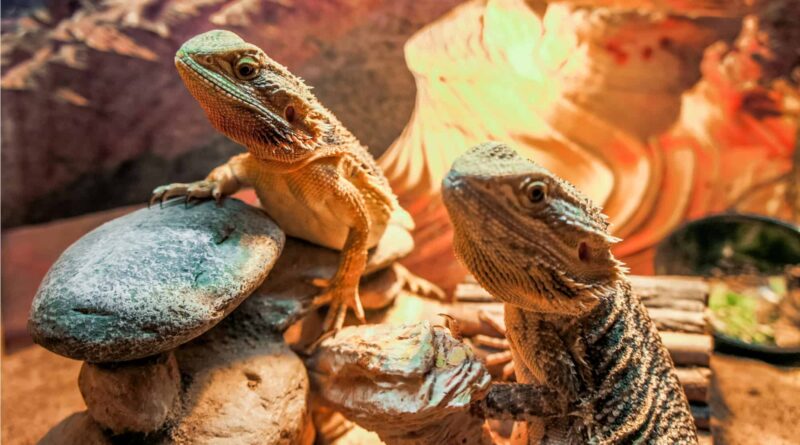Heating Lamp For Bearded Dragons
The right heating lamp for your beardie dragon is one that will provide your beardie with all-around full spectrum lighting. Some types have a safety feature that allows the bulb to turn off when it gets too hot and turn on again when it is cool. Some heating lamps are made with a vertical mounting system for even distribution of light.
Our Favorite Basking Spot Lamp
If you’re looking for a quality basking spot lamp for your reptiles, you’ve come to the right place. The Repti Basking Spot Lamp features a patented double reflector that focuses light and heat into a narrow beam to provide the optimum basking environment. It’s the perfect light source for both tropical and desert reptiles.
Reptiles regulate their body temperature by alternating between regions of cold and warmth. Maintaining the correct temperature is essential to their digestion, defense against disease, and bodily functions. The Zoo Med Repti Basking Spot Lamp features an incandescent spot-style heat bulb that focuses 35% more heat than a regular spot lamp. The lamp’s double reflector technology also provides better heat output and reduces the risk of burns for your reptiles.
Temperature Guidelines For Bearded Dragons
Generally, the temperature of bearded dragons varies, depending on the size of the bearded dragon and the age of the dragon. However, younger dragons usually prefer a higher temperature, since they consume more insects and have higher digestive requirements than adult beardies. They also prefer to bask in hotter spots.
Bearded dragons prefer a temperature around 70degF at night. A temperature below that will make it feel uncomfortable, and you should use a portable heater to raise its temperature. Bearded dragons can also survive in temperatures as low as 63degF, but you should avoid temperatures below that. It is important to provide appropriate heat during the daytime to keep the beardie comfortable.
To keep your beardie comfortable, set up a basking area with a hotter end and a cool shaded end. The hot end should be equipped with a 10-12 per cent fluorescent UV tube. This helps keep the beardie from developing metabolic bone disease. You should also keep the humidity in the cooler end of the vivarium at a low level. A hygrometer can help you monitor the humidity.
Nighttime Heat Lamps
Your bearded dragon should be kept in a temperature-controlled environment at all times. If it’s too cold or too hot, you should reduce the heat lamp wattage to keep your beardie comfortable. You should also avoid using red light, which can damage your beardie’s eyes and weaken its immune system.
Select a bulb with the wattage that matches the current room temperature. Also, keep in mind the type of enclosure. Glass enclosures produce more moisture and heat than other materials, so look for a lamp that can regulate the internal temperature of the tank. Make sure to choose a bulb with a dimmer switch to help regulate the heat.
Bearded dragons also need to sleep, so you should turn off the heat lamp at night. It’s better to mimic their natural environment, such as cooler night temperatures, than overheating them in the cage. You can use timers to adjust the heat and light schedules.
Undertank Heat Pads
Undertank heat pads are an excellent way to provide constant warmth for your bearded dragon. This type of heater has a thermostat and is attached to your bearded dragon’s tank via an adhesive part. Depending on the species, the temperature of your beardie’s habitat may need to be adjusted as needed. These heating pads are safe and simple to use.
A good heating pad will provide even warmth on either side of the beardie’s tank. A good option is the Zoo Med Reptile Heat Pad. This heating pad is advertised as an under tank heater and has a large adhesive base so it won’t slide out of place. It also offers the best possible heat exchange, which lowers running costs. One caveat is that it is only compatible with glass terrariums. It is also not very attractive if it is accidentally folded.
A good beardie heat pad comes in a variety of sizes. If you have a large tank, you may need more than one heating pad. These beardie dragon heat pads can be placed on different ends of the terrarium to provide additional heat for your beardie. These heating pads can help your beardie stay warm during the winter months.
Review Of The Best Heat Lamps For Bearded Dragon
The wattage of a heat lamp for bearded dragons varies based on the size of the bearded dragon’s tank and its age. Hatchlings and subadults will need a bulb rated at around 40 watts, while adults will require an 80 to 100 watt bulb. Keep in mind that a larger tank will mean more space for the heat lamp to warm, so you can purchase a larger bulb if needed.
A good heat lamp for a bearded dragon should have a regulated temperature so your beardie doesn’t overheat. A bulb should not be placed on the surface of the bearded dragon, since it can get too hot. Another feature of heat lamps for bearded dragons is dimmability.
A heat lamp for bearded dragons should also provide a steady temperature and UVA and UVB light. If you choose to purchase a lamp, make sure that you choose one that is made specifically for reptiles. Some heat lamps are made with ceramic or porcelain sockets, which means your beardie can withstand higher temperatures without getting burned.
Zoo Med Deluxe Porcelain Clamp Lamp
The Deluxe Porcelain Clamp Lamp is a durable, UL-certified lamp that is ideal for reptiles. It works with all types of heat lamps, including ceramic and compact fluorescent UVB lamps. The lamp comes with an inline on/off switch and polished aluminum dome. The fixture also features a safety wire.
This lamp’s unique design features a deep dome with extra-long reflector. This design allows the lamp to be placed further away from the face of the lamp, and prevents the lamp from sticking out the end of the fixture. This lamp also features a highly polished aluminum surface inside the dome, which greatly increases UVB and UVA output.
The Zoo Med Deluxe Porcelain Clamp lamp is available in two sizes. The 14cm version features a ceramic socket that is rated for 100-watts, while the larger 22cm version can accommodate 150-watt bulbs. The deluxe version comes with an on/off switch and is suitable for use in screen-top terrariums and igua cages.
Ceramic Heat Emitters
Using ceramic heat emitters for your bearded dragon can be safe and effective. However, there are some precautions you need to follow. For example, don’t touch the lamp when it’s on, because it’s extremely hot and it might cause burns on your fingers or hands. Also, ceramic heat emitters should be set up far away from flammable materials.
Before purchasing ceramic heat emitters for your Bearded dragon, make sure to check its temperature. Try to keep it at a level of about 65 degrees F, which is above the room temperature. Having a thermometer near your Bearded Dragon can make the whole process easier.
Using ceramic heat emitters for your bearded dragon is safer than using under tank heaters. Ceramic heat emitters also provide heat during the night, and they don’t produce any light. Moreover, you can control the temperature with a pulse thermostat.
Thermometers
Thermometers for bearded Dragons can help keep your pet healthy by measuring its body temperature accurately and providing a convenient way to monitor your pet’s health. It’s important to choose a high-quality thermometer for your dragon. It should not break or require replacement batteries often. It also should have a long life. There are many different types of thermometers on the market. Choose one that can read both degrees Fahrenheit and Celsius.
If you’re not prepared to spend a lot of money, you can opt for a cheaper alternative. An Exo Terra hygrometer can provide accurate temperature and humidity readings. However, it doesn’t come with wireless capabilities and requires you to shift the probe. Therefore, it’s not as convenient as the SensorPush.
Digital thermometers are another good option for bearded dragons. These thermometers have a display that is easy to read. They can measure the temperature in Celsius or Fahrenheit and usually have a wide range. Digital thermometers also include a humidity gauge. They are easy to install and use.
Visit our site: Infowars




